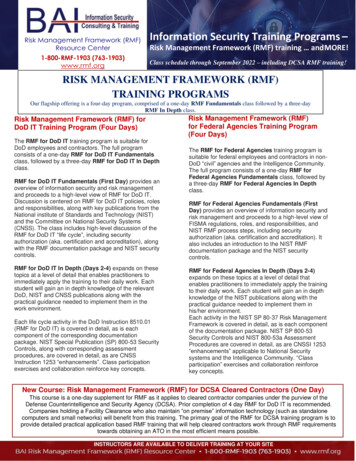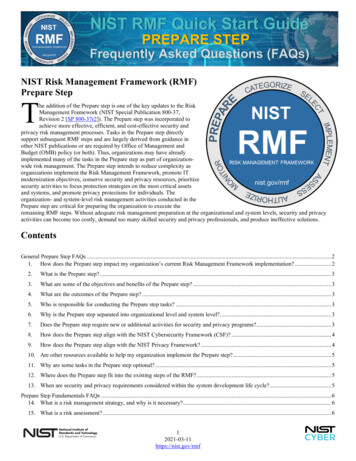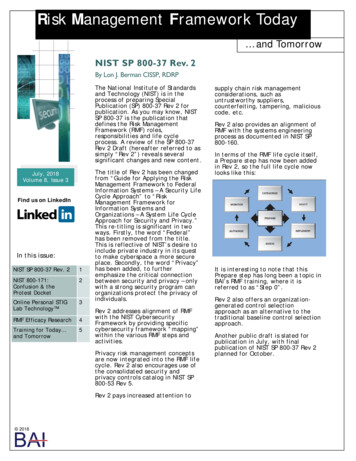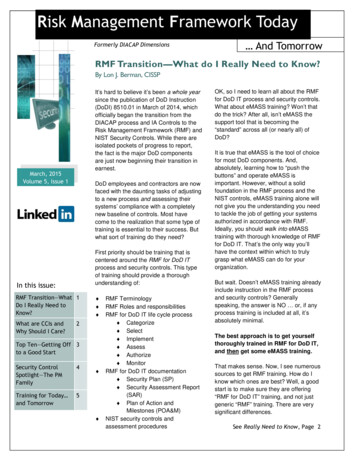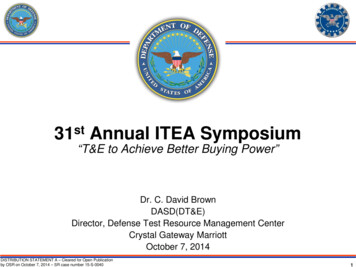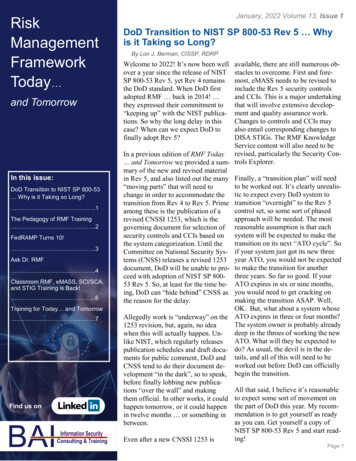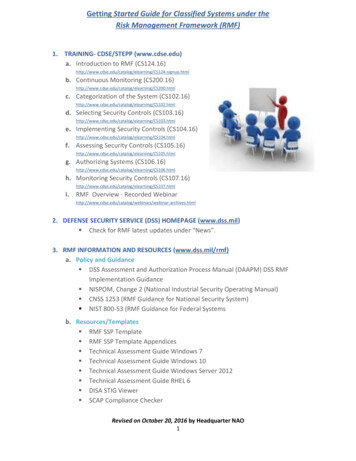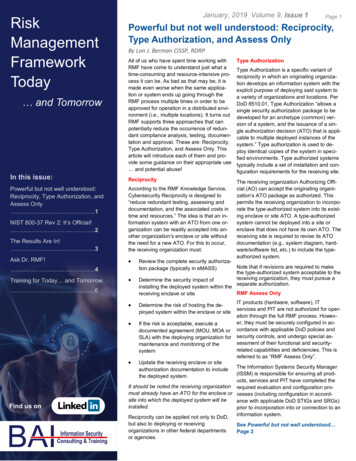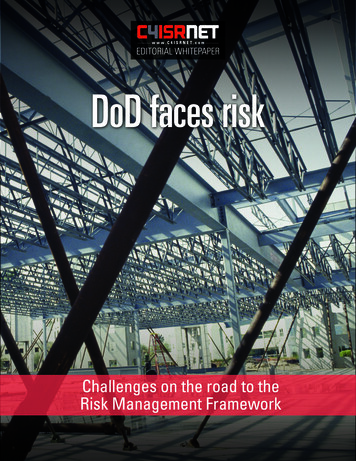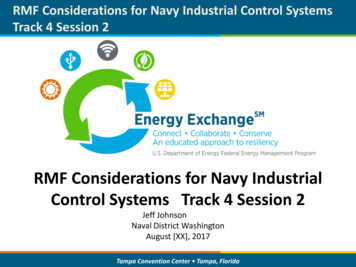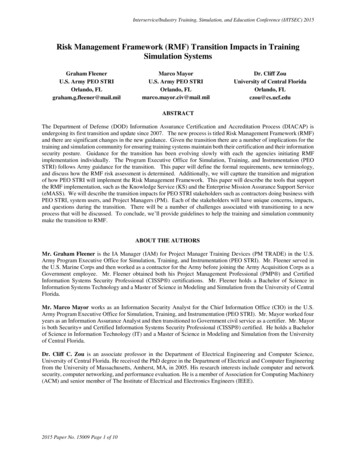
Transcription
Interservice/Industry Training, Simulation, and Education Conference (I/ITSEC) 2015Risk Management Framework (RMF) Transition Impacts in TrainingSimulation SystemsGraham FleenerU.S. Army PEO STRIOrlando, FLgraham.g.fleener@mail.milMarco MayorU.S. Army PEO STRIOrlando, FLmarco.mayor.civ@mail.milDr. Cliff ZouUniversity of Central FloridaOrlando, FLczou@cs.ucf.eduABSTRACTThe Department of Defense (DOD) Information Assurance Certification and Accreditation Process (DIACAP) isundergoing its first transition and update since 2007. The new process is titled Risk Management Framework (RMF)and there are significant changes in the new guidance. Given the transition there are a number of implications for thetraining and simulation community for ensuring training systems maintain both their certification and their informationsecurity posture. Guidance for the transition has been evolving slowly with each the agencies initiating RMFimplementation individually. The Program Executive Office for Simulation, Training, and Instrumentation (PEOSTRI) follows Army guidance for the transition. This paper will define the formal requirements, new terminology,and discuss how the RMF risk assessment is determined. Additionally, we will capture the transition and migrationof how PEO STRI will implement the Risk Management Framework. This paper will describe the tools that supportthe RMF implementation, such as the Knowledge Service (KS) and the Enterprise Mission Assurance Support Service(eMASS). We will describe the transition impacts for PEO STRI stakeholders such as contractors doing business withPEO STRI, system users, and Project Managers (PM). Each of the stakeholders will have unique concerns, impacts,and questions during the transition. There will be a number of challenges associated with transitioning to a newprocess that will be discussed. To conclude, we’ll provide guidelines to help the training and simulation communitymake the transition to RMF.ABOUT THE AUTHORSMr. Graham Fleener is the IA Manager (IAM) for Project Manager Training Devices (PM TRADE) in the U.S.Army Program Executive Office for Simulation, Training, and Instrumentation (PEO STRI). Mr. Fleener served inthe U.S. Marine Corps and then worked as a contractor for the Army before joining the Army Acquisition Corps as aGovernment employee. Mr. Fleener obtained both his Project Management Professional (PMP ) and CertifiedInformation Systems Security Professional (CISSP ) certifications. Mr. Fleener holds a Bachelor of Science inInformation Systems Technology and a Master of Science in Modeling and Simulation from the University of CentralFlorida.Mr. Marco Mayor works as an Information Security Analyst for the Chief Information Office (CIO) in the U.S.Army Program Executive Office for Simulation, Training, and Instrumentation (PEO STRI). Mr. Mayor worked fouryears as an Information Assurance Analyst and then transitioned to Government civil service as a certifier. Mr. Mayoris both Security and Certified Information Systems Security Professional (CISSP ) certified. He holds a Bachelorof Science in Information Technology (IT) and a Master of Science in Modeling and Simulation from the Universityof Central Florida.Dr. Cliff C. Zou is an associate professor in the Department of Electrical Engineering and Computer Science,University of Central Florida. He received the PhD degree in the Department of Electrical and Computer Engineeringfrom the University of Massachusetts, Amherst, MA, in 2005. His research interests include computer and networksecurity, computer networking, and performance evaluation. He is a member of Association for Computing Machinery(ACM) and senior member of The Institute of Electrical and Electronics Engineers (IEEE).2015 Paper No. 15009 Page 1 of 10
Interservice/Industry Training, Simulation, and Education Conference (I/ITSEC) 2015Risk Management Framework (RMF) Transition Impacts in TrainingSimulation SystemsGraham FleenerU.S. Army PEO STRIOrlando, FLgraham.g.fleener@mail.milMarco MayorU.S. Army PEO STRIOrlando, FLmarco.mayor.civ@mail.milDr. Cliff ZouUniversity of Central FloridaOrlando, FLczou@cs.ucf.eduINTRODUCTIONThe Department of Defense (DOD) has been following the DOD Information Assurance Certification andAccreditation Process (DIACAP) since 2007. On March 12, 2014, the DOD released guidance to supersede DIACAP.The process is now titled Risk Management Framework (RMF) for DOD Information Technology (IT) and numberedDOD Instruction 8510.01 (DOD, 2014). There are a number of changes associated with transitioning to the RMFprocess to include migrating from DOD security controls to National Institute of Standards and Technology (NIST)Security Controls. The transition will be an evolving process that will take place incrementally with systems currentlyaccredited under DIACAP phased in under RMF. The training and simulation community is made up of a numberof stakeholders that have unique impacts and challenges they will face with the transition to RMF. This paper willdocument impacts from the industry contractor, training system user, and Project Manager (PM) perspectives. Toconclude, this paper will outline the evolving guidelines and best practices for understanding RMF as it is known atthe date of publication.The background of the DOD migrating from DIACAP to RMF began in an effort to consolidate and standardizeinformation risk management for the federal government. Prior to RMF, the DOD used a unique certification andaccreditation process for Information Assurance, which differed from other federal agencies. There are a number ofbenefits to having the entire federal government under one process (DISA, 2012). First, RMF is intended to providea greater degree of confidence for users, to include warfighters, that the systems they are operating on a daily basisare more secure. Next, reciprocity, or the ability to leverage a previously granted authorization across agencies couldbe realized under a single process. Using the same security control requirements would enable a more standardapproach to measuring cybersecurity risk. Additionally, this will standardize the language used for informationassurance across the entire federal government. DIACAP was largely a static process with time driven milestones toinclude triennial reaccreditations, annual security reviews and few requirements for continuous monitoring of thesecurity posture of a system. RMF is placing a significant emphasis on real time security. The continuous monitoringof the security posture of a system, to include reporting metrics and compliance to a higher agency, is one of thecornerstones for the transition to RMF.There will be a number of challenges DOD wide with the transition to a new process for information securitycompliance. This paper will concentrate on the challenges the cyber community within the U.S. Army ProgramExecutive Office for Simulation, Training, and Instrumentation (PEO STRI) will face with the transition to RMF.However, many of the challenges will not necessarily be unique to PEO STRI. Figure 1, DIACAP to RMF Transition,documents a brief snapshot of the key differences in the migration to the new process.Figure 1 – DIACAP to RMF Transition2015 Paper No. 15009 Page 2 of 10
Interservice/Industry Training, Simulation, and Education Conference (I/ITSEC) 2015RMF REQUIREMENTS AND GUIDANCEThere are a number of significant changes that will take place with the transition from DIACAP to RMF. DIACAPrequired a system to perform a reaccreditation every three years, or triennially. RMF will initially continue withtriennial reaccreditations, but will begin phasing in a process called continuous reauthorization (DODI 8510.01, p.38). Continuous reauthorizations allow for a system to eliminate the formal triennial reaccreditation process as longas a number of conditions are met. Continuous monitoring and strong security compliance metrics will be paramountto obtaining a continuous reauthorization decision. Under DIACAP, periodic (typically quarterly) patch updates werea sufficient means of remaining in compliance with an Information Assurance Vulnerability Management (IAVM)Plan. With the release of RMF, the DOD is phasing in a requirement for real time reporting of patch status. The endgoal of the reporting is to decrease the time between patch cycles and decrease the known vulnerability of installedsystems. The next major change is moving from the DOD Instruction 8500.2 security controls to the National Instituteof Standards and Technology (NIST) Special Publications (SP) 800-53 security controls. NIST SP 800-53 has a muchmore granular approach to security controls. Figure 2, RMF Process, below documents the RMF steps, whichcoincides with a system’s life cycle. Figure 2 is referenced from DODI 8510.01 page 28 which further documentseach step of the process.Figure 2 – RMF ProcessThere are a number of requirements publications associated with RMF governing policy, procedures, and technicalsecurity controls. Table 1, RMF Requirements Publications, outlines the high level guidance provided to supportRMF implementation. The intent of the vast amount of guidance is to ensure agencies, contractors, and otherstakeholders have the necessary information to minimize the cyber threat to systems.2015 Paper No. 15009 Page 3 of 10
Interservice/Industry Training, Simulation, and Education Conference (I/ITSEC) 2015Table 1 – RMF Requirements PublicationsNumberDODI 8500.01NameCybersecurityDODI 8510.01Risk Management FrameworkNIST SP 800-39Managing Information SecurityRiskNIST SP 800-37Risk Management FrameworkNIST SP 800-30Risk AssessmentNIST SP 800-53Cybersecurity Controls andEnhancementsNIST SP 800-53ACybersecurity Control AssessmentProceduresInformation Security ContinuousMonitoringMapping Types of Information toSecurity CategoriesNIST SP 800-137NIST SP 800-60NIST SP 800-160Systems Security EngineeringCNSSP 22Policy on Information AssuranceRisk Management Policy forNational Security SystemsSecurity Categorization and ControlSelection for National SecuritySystemsImplementation and AssessmentProceduresCNSSI 1253CNSSI 1253ACNSS 4009National Information AssuranceGlossarySummaryProvides the foundation for establishing a DODcybersecurity program for defense of networks,systems and information technology to includedefinitions of terms, security controls guidance,and enterprise governance.Establishes a policy governing cybersecurity,assigns responsibilities, and details execution ofthe RMF process.Documents a program for understanding andassessing information security risk within anorganization.Provides guiding principles for implementing RMFon federal information systems to ensureconsistency, full integration, and more secureconfiguration of security controls on a system.Documents a strategy for conducting riskassessments on information systems andorganizations as a part of an overall riskmanagement process.Establishes guidelines for assigning securitycontrols for the purposes of achieving secureoperations of information systems.Initial point for defining assessment procedures forapplicable security controls for a given system.Assists organizations in the implementation of acontinuous monitoring strategy.Supports organizations in the process of aligninginformation and information systems with theappropriate security category in a consistentmanner.Provides a comprehensive guideline of theprinciples and concepts of security engineering forfederal information systems.Serves as the requirement for establishing anorganizational Information Assurance policy forNational Security Systems.Provides a foundation for selecting and applyingsecurity controls from NIST SP 800-53 forimplementation on a National Security System.Establishes a guideline for assessing compliancewith applicable security controls on a NationalSecurity System.Documents a detailed glossary of InformationAssurance related terms in an effort to minimizedifferences in terminology to ensure consistencyand standardization.Transition GuidanceAs agencies interpret the DOD level guidance, each one is publishing transition guidance. The transition guidancePEO STRI has received is for an RMF implementation date of October, 2015.2015 Paper No. 15009 Page 4 of 10
Interservice/Industry Training, Simulation, and Education Conference (I/ITSEC) 2015RMF TOOLS SUPPORTING IMPLEMENTATIONKnowledge Service (KS)The KS is a web-based resource that provides RMF users access to RMF policy and guidance on how to implementmethods standards, and practices required to protect DOD systems. The KS contains the most updated guidanceaddressing the always-evolving security objectives and risk conditions. It provides access to security controlsbaselines, overlays, individual security controls and security control implementation guidance and assessmentprocedures. The KS website contains a library of tools, diagrams, process maps, etc. assisting users execute the RMFprocess. Access to the KS website (https://rmfks.osd.mil) is only available to users with a Common Access Card(CAC) or with external DOD sponsorship, for example, DOD contractors without a CAC (Department of Defense,2014).Enterprise Mission Assurance Support Service (eMASS)The eMASS is also a web-based resource that automates the RMF process. It includes all the reports required by theRMF process, and it’s able to generate new reports based on the user’s needs. eMASS main vision is to allow usersto share access to specific data in near real-time, and in a secure fashion. It integrates several capabilities, such as: Reporting on a system’s cybersecurity compliancy Simplifying the RMF workflow automation. Standardizing the exchange of information Tracking systems-security engineering during the entire life cycleAccess to the eMASS website is only available to users with a Common Access Card (CAC) or with external DODsponsorship (Department of Defense, 2014). At this time all systems for the Army must be transitioned into eMASS.OTHER TOOLS SUPPORTING CONTINUOUS MONITORING REQUIREMENTIn the DIACAP process some compliance tools were standalone in nature. RMF instead is transitioning into moreconnection-dependent tools. DOD has combined three emerging security practices tasked with the sole purpose toprovide training systems with near real-time IA situational awareness. These applications are the Assured ComplianceAssessment Solution (ACAS), Host Based Security System (HBSS), and the Continuous Monitoring Risk Scoring(CMRS) system. These three tools all depend on one another to provide a system’s accurate risk posture. Thechallenges users and system owners will be facing, is the ability to provide continuous data feeds in standalone orclosed-restricted environments.Assured Compliance Assessment Solution (ACAS)The Assured Compliance Assessment Solution (ACAS) suite is provided at no cost to DOD agencies by the DefenseInformation System Agency (DISA). It is a scalable suite of COTS applications, which has the ability to provideautomated network vulnerability scanning, configuration assessment, application vulnerability scanning, deviceconfiguration assessment, Security Technical Implementation Guides (STIG) compliance, and network discovery(ACAS, 2014). ACAS automates a lot of the vulnerability scanning ground work, but it is a suite that was gearedtowards a Global Information Grid (GIG) connected enterprise type of environment, and not a standalone/closedrestricted environment. Security professionals operating ACAS in standalone/closed-restricted environments, willhave to download all the latest software updates from a connected system, and manually install them in the ACASstandalone architecture. This extra step introduces manual labor, and human error.Host Based Security System (HBSS)The HBSS suite is provided at no cost to DOD agencies by DISA, and it comes in the form of a pre-configured image(ePO server) and individual installation packages (all other point components). HBSS is a COTS suite of softwareapplications which monitor, detect, and counter against acknowledged cyber-threats to systems and networks. UnlikeACAS, the HBSS solution is installed on each host (server, desktop, and laptop). HBSS is normally managed by localadministrators and configured to lower intrusion risk using an Intrusion Prevention System (IPS) and a host firewall.Once installed, a manual security review is still required. (HBSS, 2014). Similar to ACAS, automated software2015 Paper No. 15009 Page 5 of 10
Interservice/Industry Training, Simulation, and Education Conference (I/ITSEC) 2015updates to the HBSS components depend on a connection to the GIG, adding an extra layer of complexity to securityprofessionals administrating systems in standalone/closed-restricted environments.Continuous Monitoring Risk Scoring (CMRS)The CMRS suite is provided at no cost to DOD agencies by DISA. It is a web-based tool that visualizes and quantifiesthe cybersecurity risk of the system based on published asset inventory (provided by HBSS) and the compliance data(provided by ACAS), via a dashboard. CMRS allows users to gather decision-making information, implementprioritized mitigation decisions, and ensure effectiveness of security controls in order to support their cybersecurityrisk management duties (CMRS, 2014). By using CMRS, network defenders will be able to determine if their assetsare configured securely. If their configuration has changed, it will provide them with situational awareness on how toeffectively apply cyber defense resources.One of the challenges DOD faces is ensuring standalone/closed-restricted systems comply with the continuousmonitoring requirement. For these types of systems, DISA proposes sneaker netting XML ACAS and HBSS feedsmanually to the CMRS portal. Similar to the Vulnerability Management System (VMS) implemented in the DIACAPprocess, the CMRS will aggregate sensitive data, which must be accessed only by authorized users. DOD hasimplemented different safeguards to control access to the portal. For example, providing DOD sponsorship toauthorized individuals only, and the usage of token-based technology, such as Common Access Cards (CACs).Figure 3, Continuous Monitoring Emerging Security Practices shows the relationship between the different emergingtechnologies, and their corresponding users at the different levels. As shown below, the ACAS data and HBSS datais submitted to the CMRS in an XML format, and then is forwarded to the eMASS.Figure 3 – Continuous Monitoring Emerging Security PracticesIn the next sections, we’ll be identifying the transition implications to the end-users, the DOD contractors, andmembers of DOD in general. Also, we’ll address some of the transition implications involving technology.The user community in most cases, is identified as the warfighters themselves who interact with these training systems.They normally train under the oversight of a DOD instructor. In other situations, the end-users are DOD contractorsoperating and maintaining these systems. Finally, members of DOD affected by the transition include but are notlimited to the Program Management Offices (PMOs) and contractors. Their job is to ensure compliance with thecontinuous monitoring requirement, and security posture of the system. Figure 3, displays the roles and interactionbetween these three parties and the training system.2015 Paper No. 15009 Page 6 of 10
Interservice/Industry Training, Simulation, and Education Conference (I/ITSEC) 2015Figure 4 – Relationship between End-users, DOD Contractors and DODTRANSITION IMPLICATIONS FOR USERSPrivacyOnce RMF is implemented, privacy for the end-users will be affected as well. End-users will now be continuouslymonitored by the emerging tools mentioned in the last section. Network topologies, computer services, vulnerabilities,user accounts, and other data will now be reported by HBSS and ACAS to the CMRS. At the time this research wasdone, eMASS was deployed with minimal security controls protecting the need-to-know principal. In other words,all registered users have the capability of searching and viewing other organization’s systems RMF information. Interms of privacy for CMRS, the overall compliancy scores are now reflected in almost real time, providing visibilityto external entities such as auditors or authorizing officials. Under this new type of monitoring end-users are expectedto comply with the applicable security controls. Violations and deviations will be tracked and reported by these tools,specifically HBSS. Similarly, the end user will lose the flexibility of keeping certain aspects of the systemconfidential. Previously under the DIACAP process, violations and security control deviations were only evident tothe system owner.Risk ScoringThe risk scoring capability will provide compliancy metrics visible to auditors, senior leadership, and other entitieswith the respective need to know. The concern users have is the accuracy of these metrics. The legitimacy of theactual risk score is directly dependent on the accuracy of the metrics. The risk scores are computed by a number offactors. For HBSS the risk factors include timeliness of reporting data, compliance to the HBSS software baseline,current antivirus signature file, patch compliance, and STIGs rule compliance. For ACAS the risk factors includetimeliness of reporting data, patch compliance, and STIGs rule compliance (CMRS, 2014). A negative finding istriggered when a system does not report to CMRS regularly due to a configuration error, a network issue, or a hardwareproblem. Since stand-alone systems depend on manual feeds, lack of manpower required to do these XML feeduploads will also affect the risk compliance scores adversely. These negative findings raise the risk score of the systemcausing the appearance of a greater risk level than may be actually be present. Conversely, the risk score may also beincreased if the system is reporting false positives. A false positive occurs when the vulnerability scanning softwareincorrectly reports a risk on a system that is not actually present.TRANSITION IMPLICATIONS FOR CONTRACTORSIntegration of RMF Tools in Design PhaseThere are a number of considerations contractors will need to address when developing systems under the RMFprocess. The government will be updating Statements of Work (SOW) to ensure the requirements are defined. Theimplications for contractors will include implementation and integration of the previously addressed governmentlicensed Commercial Off The Shelf (COTS) tools into a system as it is developed. Contractors will want to payparticular attention to ensure the tools are configured to allow for secure operations while maintaining overallfunctionality. Additionally, processes will need to be developed and documented by the development contractor toensure the life cycle support team has the ability to maintain secure operations of the continuous monitoring andreporting COTS tools.2015 Paper No. 15009 Page 7 of 10
Interservice/Industry Training, Simulation, and Education Conference (I/ITSEC) 2015Proposing Work for RMFAccurately bidding hours to support a Request For Proposal (RFP) is one of the key concerns contractors have in anynew process transition. At the time of the writing of this document, the RMF transition process is still being defined.The initial documents for RMF were released on March 14, 2014. As stated earlier in the paper the agencies areimplementing RMF with some level of differences making proposing for work with RMF challenging. There are anumber of unknowns in the assessment and authorization process that will be addressed with time. However, systemsecurity engineering principles and concepts remain the same for the development contractor. There are additions ofnew tools and technologies for RMF that will need to be clearly identified in future RFPs from the government as theyare phased into implementation.TrainingThe DOD will be responsible to ensure that adequate RMF training and guidance materials are available to industry.One of the challenges with implementing a significant change is ensuring industry has an understanding of theprocesses associated with safeguarding a system under RMF guidance. At the PEO STRI level, there is anticipated tobe a number of training opportunities for our industry partners as well as the government cybersecurity workforce. Inaddition, there are a number of private companies already providing RMF training at a cost.TRANSITION IMPLICATIONS FOR TECHNOLOGYMore Technical Expertise and New Hardware RequirementsIn the DIACAP process, users generated vulnerability reports from scanning tools like Retina, Gold Disk, and theSecurity Content Automation Protocol (SCAP) Compliance Checker (SCC). All three tools operated in a Windowsenvironment, so the tools could all reside in one operating system. Some emerging tools in RMF, are implemented indifferent operating systems (OS), requiring cyber security professionals to have a higher level of technical experience.For example, SecurityCenter, which is part of the ACAS suite, only operates in a Red Hat Enterprise Linux (RHEL)operating system, and all the other suite components run under a Windows OS. The training requirements for theseemerging tools is more extensive. The ACAS and HBSS online trainings are both 32 hours long, and they’re providedby the Federal Virtual Training Environment (FedVTE).As far as hardware specifications are concerned, both HBSS and ACAS suites require a set of minimum requirements,so that they can operate efficiently. Based on STIG requirements, end-users cannot have all the emerging tools operateon one physical device. HBSS for example, must run independently in its own physical server.Another transition impact is the increased dependence on network connectivity. Operators will now be entering datadirectly onto the eMASS portal and not into separate artifacts, such as the System Identification Profile and theDIACAP Implementation Plan. The dependence on a connection to access eMASS will increment, as at the time ofthe research, a stand-alone version of eMASS was not available.Risk ScoringFor near real-time risk scoring, training systems will require a network connection to the CMRS portal or at least thecapability to manually import XML feeds into the CMRS portal. This poses a challenge for standalone/closedrestricted environments, because failure to report to CMRS generates a negative impact on the risk score. So designerswill have implement fail-safe measures in a connected environment. A way to mitigate network interruption, may beby ensuring a network redundancy if feasible, or implement an alerting mechanism which sends the systemadministrator an immediate alert if this happens. Or in the case of a standalone/closed restricted environment, thesystem owner may have to enforce a strict policy stating the duties and responsibilities of a system administrator,including time intervals in which these XML feeds need to be manually imported.TRANSITION IMPLICATIONS FOR DODThere are a number of challenges included with transition to RMF for the DOD community. By DOD community weare referring to stakeholders not previously mentioned such as Government Project Managers, DOD cybersecurityworkforce, and RMF certification testing teams. The challenges associated with transition implications for the DODcommunity include ensuring adequate training for the cybersecurity workforce, defining RMF requirements in2015 Paper No. 15009 Page 8 of 10
Interservice/Industry Training, Simulation, and Education Conference (I/ITSEC) 2015Request For Proposals (RFP) for upcoming acquisitions, and budgeting for any possible increases in cost resultingfrom RMF. DOD is developing a number of training packages available to the cybersecurity workforce. As theprocess matures at the agency level more training opportunities will be available for both government and industry.At the time of writing this paper, PEO STRI is incorporating RMF language in all RFPs released after May 2014.This will ensure PEO STRI remains agile to meet RMF requirements for future systems going through the acquisitionprocess.FUTURE WORKThere are a number of future actions and work efforts that will take place with the transition to Risk ManagementFramework. The initial future work effort will be to document the lessons learned from the first system to transitionand perform the Risk Management Framework process. After the initial system is authorized, there will be theopportunity at the PEO STRI level to refine in any way possible at our level. Additionally, future work will see anevolution in the Risk Management Framework related tools to provide greater automation and tighter access ACAPDISADODEMASSEPOGIGHBSSIAMIPSITKSNISTOSPEO STRIPMPM TRADEPMORFPRMFSCCSPSTIGVMSXMLNameAssured Compliance Assessment SolutionBasic Accreditation ManualCommon Access CardCertified Information Systems Security ProfessionalContinuous Monitoring Risk ScoringCommercial Off The ShelfDOD Information Assurance Certification and Accreditation ProcessDefense Information Systems AgencyDepartment of DefenseEnterprise Mission Assurance Support ServiceePolicy OrchestratorGlobal Information GridHost Based Security SystemInformation Assurance ManagerIntrusion Prevention SystemInformation TechnologyKnowledge ServiceNational Institute of Standards and TechnologyOperating SystemProgram Executive Office for Simulation, Training, and InstrumentationProject ManagerProject Manager Training DevicesProgram Management OfficeRequest For ProposalRisk Management FrameworkSCAP Compliance CheckerSpecial PublicationSecurity Technical Implementation GuidesVulnerability Management SystemExtensible Markup Language2015 Paper No. 15009 Page 9 of 10
Interservice/Industry Training, Simulation, and Education Conference (I/ITSEC) 2015REFERENCESDefense Information Systems Agency. (2014)
RMF is placing a significant emphasis on real time security. The continuous monitoring of the security posture of a system, to include reporting metrics and compliance to a higher agency, is one of the cornerstones for the transition to RMF. There will be a number of challenges DOD wide with the transition to a new process for information security
